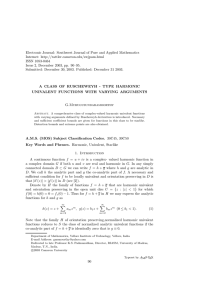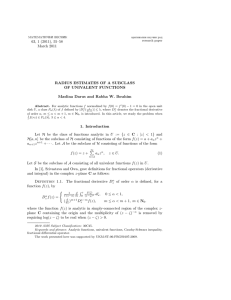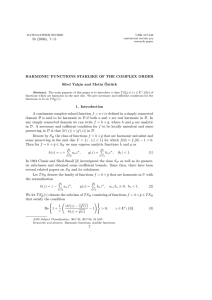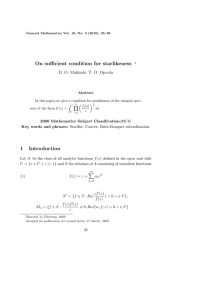Document 10812954
advertisement
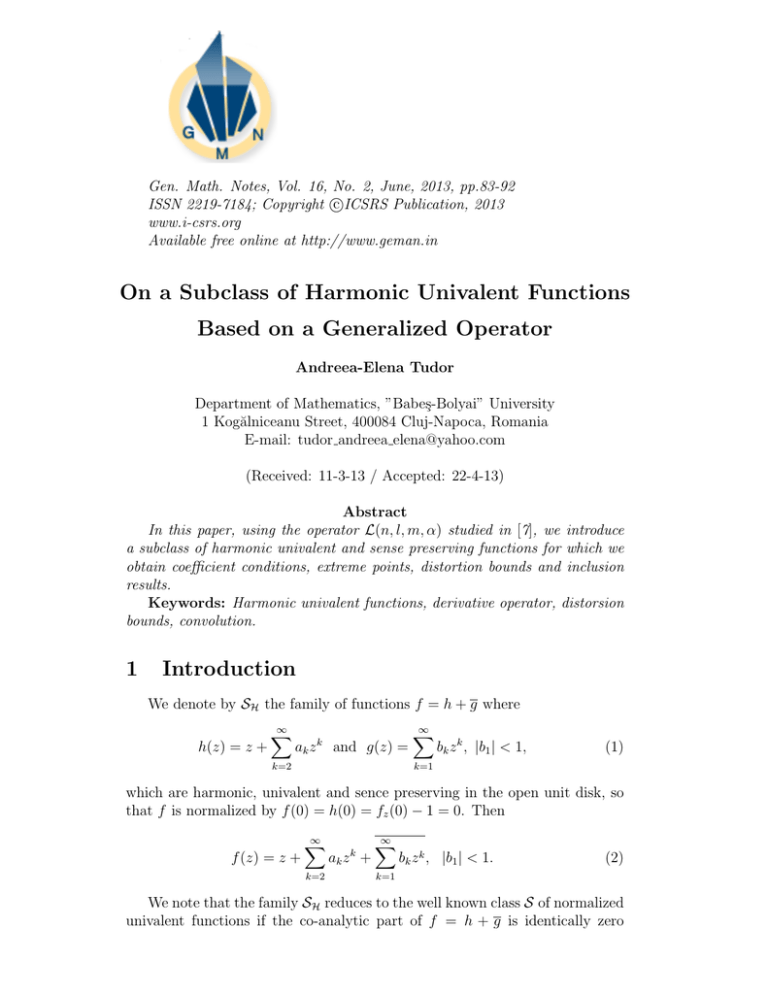
Gen. Math. Notes, Vol. 16, No. 2, June, 2013, pp.83-92 c ISSN 2219-7184; Copyright ICSRS Publication, 2013 www.i-csrs.org Available free online at http://www.geman.in On a Subclass of Harmonic Univalent Functions Based on a Generalized Operator Andreea-Elena Tudor Department of Mathematics, ”Babeş-Bolyai” University 1 Kogălniceanu Street, 400084 Cluj-Napoca, Romania E-mail: tudor andreea elena@yahoo.com (Received: 11-3-13 / Accepted: 22-4-13) Abstract In this paper, using the operator L(n, l, m, α) studied in [7], we introduce a subclass of harmonic univalent and sense preserving functions for which we obtain coefficient conditions, extreme points, distortion bounds and inclusion results. Keywords: Harmonic univalent functions, derivative operator, distorsion bounds, convolution. 1 Introduction We denote by SH the family of functions f = h + g where h(z) = z + ∞ X ak z k and g(z) = k=2 ∞ X bk z k , |b1 | < 1, (1) k=1 which are harmonic, univalent and sence preserving in the open unit disk, so that f is normalized by f (0) = h(0) = fz (0) − 1 = 0. Then f (z) = z + ∞ X k=2 ak z k + ∞ X bk z k , |b1 | < 1. (2) k=1 We note that the family SH reduces to the well known class S of normalized univalent functions if the co-analytic part of f = h + g is identically zero 84 Andreea-Elena Tudor (g ≡ 0). Silverman [6] introduced the subclass of SH , denoted by SH , which contains functions of the form f = h + g where h(z) = z − ∞ X |ak |z k and g(z) = k=2 ∞ X |bk |z k , |b1 | < 1. (3) k=1 If f = h + g ,where h and g are of the form (3), and F = H + G where H(z) = z − ∞ X |Uk |z k and G(z) = k=2 ∞ X |Vk |z k , k=1 then the convolution product of f and F is given by f (z) ∗ F (z) = z − ∞ X k=2 k |ak ||Uk |z + ∞ X |bk ||Vk |z k , |b1 | < 1. k=1 In [7] was introduced the operator L(n, l, a, c, α) for analytic functions defined by n ∞ X l+k (a)k−1 L(n, l, a, c, α)f (z) = z + α + (1 − α) ak z k , l+1 (c)k−1 k=2 where n, l, a ∈ N, α ∈ [0, 1), c 6= 0, −1, −2, . . . and (x)k the Pochhammer symbol given by k=0 1, (x)k := x(x + 1)(x + 2)...(x + k − 1), k ∈ N∗ For c = 1 and a = m + 1 we have n ∞ X l+k + (1 − α)C(m, k) ak z k , L(n, l, m, α)f (z) = z + α l+1 k=2 (4) m+k−1 where C(m, k) = . m Now, for f = h + g given by (2), we introduce the modified operator L(n, l, m, α) of harmonic univalent function f as L(n, l, m, α)f (z) = L(n, l, m, α)h(z) + L(n, l, m, α)g(z), where n ∞ X l+k L(n, l, m, α)h(z) = z + α + (1 − α)C(m, k) ak z k l+1 k=2 (5) On a Subclass of Harmonic Univalent Functions... 85 and n ∞ X l+k L(n, l, m, α)g(z) = α + (1 − α)C(m, k) bk z k , |b1 | < 1. l+1 k=1 We denote by HL(n, l, m, α, γ) the class of harmonic functions f of the form (2), such that z (L(n, l, m, α)f (z))0 Re ≥ γ, 0 ≤ γ < 1. L(n, l, m, α)f (z) For m = l, we obtain the class HL(n, l, α, γ) (l + 1)L(n + 1, l, l + 1, α)f (z) Re − l ≥ γ, L(n, l, l, α)f (z) (6) where L(n, l, m, α) is defined by (5). Also, we denote by HL(n, l, α, γ) the class of functions f = h + g in HL(n, l, α, γ), where h and g are of the form (3). We notice that the class HL(n, l, α, γ) includes a variety of well-known subclasses of SH . For example, HL(0, 0, 1, γ) represent the class of sensepreserving, harmonic, univalent functions f which are starlike of order γ in U and HL(1, 0, 1, γ) represent the class of sense-preserving, harmonic, univalent functions f which are convex of order γ in U . These subclasees were introduced and studied by Jahangiri in [2]. Other subclasses studied are HL(n, 0, 1, γ) which is the class of Salagean-type harmonic univalent functions studied by Jahangiri and al. in [3] and HL(n, l, 0, γ), the class of Ruscheweyh-type harmonic univalent functions studied by Murugusundaramoorthy and Vijaya in [5]. 2 Main Results First we determine a sufficient coefficient bound for functions in HL(n, l, α, γ): Theorem 2.1. Let f = h + g be given by (2). If ∞ X n l+k (k − γ) α + (1 − α)C(l, k) (|ak | + |bk |) + |b1 | ≤ 1 − γ, l+1 k=2 (7) where l, n ≥ 0, a1 = 1, α, γ ∈ [0, 1), then f (z) is harmonic univalent, sense preserving in U and f (z) ∈ HL(n, l, α, γ). 86 Andreea-Elena Tudor Proof. If we take |z1 | ≤ |z2 | < 1 and consider the inequality (7), we have |f (z1 ) − f (z2 )| ≥ |h(z1 ) − h(z2 )| − |g(z1 ) − g(z2 )| ! ∞ ∞ X X k−1 ≥ |z1 − z2 | 1 − k|ak ||z2 | − k|bk ||z2 |k−1 k=2 k=1 ! ∞ X = |z1 − z2 | 1 − k(|ak | + |bk |)|z2 |k−1 − |b1 | k=2 ! ∞ X ≥ |z1 − z2 | 1 − k(|ak | + |bk |) − |b1 | k=2 ! n ∞ X l+k (k − γ) α + (1 − α)C(l, k) (|ak | + |bk |) − |b1 | ≥ |z1 − z2 | 1 − 1 − γ l + 1 k=2 γ |b1 | ≥ |z1 − z2 | 1 − 1 − − |b1 | = |b1 ||z1 − z2 | ≥ 0 1−γ 1−γ Hence, f (z) is univalent in U . f (z) is sense preserving in U because |h0 (z)| ≥ 1 − ∞ X k|ak ||z|k−1 > 1 − ∞ X k|ak | k=2 n k=2 ∞ X (k − γ) l+k >1− + (1 − α)C(l, k) |ak | α 1 − γ l + 1 k=2 n ∞ X l+k |b1 | (k − γ) ≥ α + (1 − α)C(l, k) |bk | + 1−γ l+1 1−γ k=2 ∞ n X (k − γ) |b1 | l+k ≥ α + (1 − α)C(l, k) |bk ||z|k−1 + 1−γ l+1 1−γ k=2 ∞ ∞ X X > k|bk ||z|k−1 + |b1 | = k|bk ||z|k−1 ≥ |g 0 (z)| k=2 k=1 Finally, we show that f (z) ∈ HL(n, l, α, γ). Using the fact that Re ω ≥ γ if and only if |1 − γ + ω| ≥ |1 + γ − ω|, it suffices to show that |(1 − γ − l)L(n, l, l, α)f (z) + (l + 1)L(n + 1, l, l + 1, α)f (z)| − − |(1 + γ + l)L(n, l, l, α)f (z) − (l + 1)L(n + 1, l, l + 1, α)f (z)| ≥ 0. So, if we set n l+k + (1 − α)C(l, k) , Ak := α l+1 On a Subclass of Harmonic Univalent Functions... 87 " # n+1 l+k l+k Bk := α + (1 − α)C(l + 1, k) = Ak , l+1 l+1 we have ∞ ∞ X X k (1 − γ − l)Ak ak z + (1 − γ − l)Ak bk z k (1 − γ − l)z + k=2 k=1 ∞ ∞ X X k k +(l + 1)z + (l + 1)Bk ak z + (l + 1)Bk bk z k=2 k=1 ∞ ∞ X X (1 + γ + l)Ak bk z k (1 + γ + l)Ak ak z k + − (1 + γ + l)z + k=1 k=2 ∞ ∞ X X k k (l + 1)Bk bk z (l + 1)Bk ak z − −(l + 1)z − k=1 k=2 ∞ ∞ X X ≥ (2 − γ)|z| − (1 − γ + k)Ak |ak ||z|k − (1 − γ + k)Ak |bk ||z|k ∞ X k=2 ∞ X k=1 |1 + γ − k|Ak |bk ||z|k |1 + γ − k|Ak |ak ||z|k − −γ|z| − ) ( k=2 k=1 n ∞ X l+k (k − γ) α = 2|z| (1 − γ) − + (1 − α)C(l, k) (|ak | + |bk |)|z|k−1 − |b1 | l + 1 k=2 ( ) n ∞ X l+k (k − γ) α > 2|z| (1 − γ) − + (1 − α)C(l, k) (|ak | + |bk |) − |b1 | . l + 1 k=2 The last expression is non-negative by (7), and so the proof is complete. If we take n, l, γ = 0 and α = 1 in the previous theorem, we obtain the following theorem, proved by Jahangiry and Silverman in [4] Corollary 2.2. Let f = h + g given by (2). If ∞ X k(|ak | + |bk |) ≤ 1 − |b1 |, k=2 ∗ then f is sense-preserving, harmonic univalent in U and f ∈ SH (the functions in SH which are starlike in U ). The harmonic function f (z) = z + ∞ X k=2 where ∞ X 2(1 − γ) 1−γ k xk z + yk z k , (k − γ)Ak [(1 − γ + k) + |1 + γ − k|]A k k=1 (8) 88 Andreea-Elena Tudor n l+k Ak = α + (1 − α)C(l, k) , l+1 and ∞ X |xk | + k=2 ∞ X |yk | = 1, k=1 shows that the coefficient bound given by (7) is sharp. The functions of the form (8) are in HL(n, l, α, γ) because ∞ X (k − γ)Ak (|ak | + |bk |) + |b1 | k=2 ∞ ∞ X X (1 − γ + k) + |1 + γ − k| Ak |bk | (k − γ)Ak |ak | + 2 k=2 k=1 ! ∞ ∞ X X = (1 − γ) |xk | + |yk | = 1 − γ. = k=2 k=1 In the next theorem we will prove the necessity of condition (7) for functions of the form f = h + g, where h and g are of the form (3). Theorem 2.3. Let f = h + g be given by (3). Then f ∈ HL(n, l, α, γ) if and only if n ∞ X l+k (k − γ) α + (1 − α)C(l, k) (|ak | + |bk |) + |b1 | ≤ 1 − γ. (9) l + 1 k=2 Proof. Since HL(n, l, α, γ) ⊂ HL(n, l, α, γ), we only need to prove the ’only if’ part of the theorem. So, for the function f of the form (3), the condition (6) is equivalent to P k (1 − γ)z − ∞ k=2 (k − γ)Ak |ak |z P∞ P Re ∞ z − k=2 Ak |ak |z k + k=1 Ak |bk |z k P∞ k k=1 (k − γ)Ak |bk |z P P∞ − ≥0 k k + z− ∞ A |a |z A |b |z k k k k k=2 k=1 The above condition must hold for all values of z, |z| = r < 1. Choosing the values of z on the positive real axis, where 0 ≤ z = r < 1, we must have P P (1 − γ) − ∞ (k − γ)Ak |ak |rk−1 − ∞ (k − γ)Ak |bk |rk−1 k=2 k=1 P P∞ Re ≥ 0. (10) k−1 + k−1 1− ∞ A |a |r k k k=2 k=1 Ak |bk |r If the condition (7) does not hold then the numerator in (10) is negative for r sufficiently close to 1. Hence, there exists a z0 = r0 in (0, 1) for which 89 On a Subclass of Harmonic Univalent Functions... the quotient in (10) is negative. This contradicts the required condition f ∈ HL(n, l, α, γ). Theorem 2.4. Let f be given by 3. Then f ∈ HL(n, l, α, γ) if and only if f (z) = ∞ X (Xk hk (z) + Yk gk (z)) , (11) k=1 where h1 (z) = z, hk (z) = z − gk (z) = z + ∞ X 1−γ z k , k ≥ 2, (k − γ)Ak 2(1 − γ) z k , k ≥ 1, ((1 − γ + k) + |1 + γ − k|)Ak (Xk + Yk ) = 1, Xk ≥ 0, Yk ≥ 0. k=1 Proof. For functions f of the form (11), we may write f (z) = ∞ X (Xk hk (z) + Yk gk (z)) k=1 = ∞ X k=1 − ∞ X k=1 Then ∞ X (k − γ) (Xk + Yk ) z − ∞ X k=2 1−γ Xk z k (k − γ)Ak 2(1 − γ) Yk z k . ((1 − γ + k) + |1 + γ − k|)Ak ∞ X (1 − γ + k) + |1 + γ − k| Ak |ak | + 1−γ 2(1 − γ) k=1 ∞ ∞ X X = Xk + Yk = 1 − X 1 ≤ 1 Ak |bk | k=2 k=2 k=1 so f ∈ HL(n, l, α, γ). Conversely, suppose that f ∈ HL(n, l, α, γ). Setting n (k − γ) α l+k + (1 − α)C(l, k) l+1 Xk = |ak | n ≥ 2, 1−γ n ((1 − γ + k) + |1 + γ − k|) α l+k + (1 − α)C(l, k) l+1 Yk = |bk | n ≥ 1, 2(1 − γ) 90 Andreea-Elena Tudor where ∞ X (Xk + Yk ) = 1, k=1 we obtain the required condition. The following theorem gives the distortion bounds for functions in the class HL(n, l, α, γ). Theorem 2.5. Let f ∈ HL(n, l, α, γ). Then, for |z| = r < 1, we have 1 |f (z)| ≤ (1 + |b1 |)r + l+2 n α l+1 + (1 − α)(l + 1) 1 1−γ − |b1 | r2 2−γ 2−γ 1 1−γ − |b1 | r2 2−γ 2−γ and 1 |f (z)| ≥ (1 − |b1 |)r − l+2 n α l+1 + (1 − α)(l + 1) Proof. ∞ ∞ ∞ X X X ak z k + bk z k = z + b1 z + ak z k + b k z k |f (z)| = z + k=1 k=2 k=2 ∞ ∞ X X |ak + bk |rk |ak + bk ||z|k ≤ (1 + |b1 |)r + ≤ |1 + b1 ||z| + ≤ (1 + |b1 |)r + k=2 ∞ X k=2 k=2 |ak + bk |r2 ∞ 1 − γ − |b1 | X (2 − γ)Ak ≤ (1 + |b1 |)r + (|ak | + |bk |)r2 (2 − γ)Ak k=2 1 − γ − |b1 | ∞ 1 − γ − |b1 | X (k − γ)Ak ≤ (1 + |b1 |)r + (|ak | + |bk |)r2 (2 − γ)Ak k=2 1 − γ − |b1 | 1 ≤ (1 + |b1 |)r + l+2 n α l+1 + (1 − α)(l + 1) 1−γ 1 − |b1 | r2 . 2−γ 2−γ Similarly we obtain the other inequality. Theorem 2.6. Let f (z) ∈ HL(n, l, α, γ) and F (z) ∈ HL(n, l, α, δ), for 0 ≤ δ ≤ γ < 1. Then f (z) ∗ F (z) ∈ HL(n, l, α, γ) ⊂ HL(n, l, α, δ). On a Subclass of Harmonic Univalent Functions... 91 Proof. Suppose that f (z) ∈ HL(n, l, α, γ) and F (z) ∈ HL(n, l, α, δ) then, by Theorem 2.3, we have ∞ X (k − γ) Ak |ak ||Uk | + ∞ X ((1 − γ + k) + |1 + γ − k|) Ak |bk ||Vk | 1 − γ 2(1 − γ) k=1 k=2 ∞ ∞ X X (k − γ) ((1 − γ + k) + |1 + γ − k|) ≤ Ak |ak | + Bk |bk | ≤ 1, 1 − γ 2(1 − γ) k=2 k=1 as |Uk | < 1, |Vk | < 1. So f (z) ∗ F (z) ∈ HL(n, l, α, γ). Let now f (z) ∈ HL(n, l, α, γ). We will show that f (z) ∈ HL(n, l, α, δ). ∞ X (k − δ) ∞ X ((1 − δ + k) + |1 + δ − k|) Ak |ak | + Ak |bk | 1 − δ 2(1 − δ) k=1 k=2 ∞ ∞ X X (k − γ) ((1 − γ + k) + |1 + γ − k|) Ak |ak | + Bk |bk | ≤ 1, ≤ 1−γ 2(1 − γ) k=1 k=2 f or 0 ≤ δ ≤ γ < 1. Therefore f (z) ∗ F (z) ∈ HL(n, l, α, γ) ⊂ HL(n, l, α, δ). 3 Acknowledgements This work was possible with the financial support of the Sectoral Operation Programme for Human Resources Development 2007-2013, co-financed by the European Social Fund, under the project number POSDRU/107/1.5/S/76841 with the title ”Modern Doctoral Studies: Internationalization and Interdisciplinarity”. References [1] N.E. Cho and H.M. Srivastava, Argument estimates for certain analytic functions defined by a class of multiplier transformation, Math. Comput Modelling, 37(1-2) (2003), 39-49. [2] J.M. Jahangiri, Harmonic functions starlike in the unit disc, J. Math. Anal. Appl., 235(1999), 470-477. [3] J.M. Jahangiri, G. Murugusundaramoorthy and K. Vijaya, Sălăgeantype harmonic univalent functions, South. J. Pure and Appl. Math., 2(2) (2002), 77-82. 92 Andreea-Elena Tudor [4] J.M. Jahangiri and H. Silverman, Harmonic univalent functions with varying arguments, Int. J. of Appl. Math., 8(3) (2002), 267-275. [5] G. Murugusundaramoorthy and K. Vijaya, On certain classes of harmonic univalent functions involving Ruscheweyh derivatives, Bulletin of the Calcutta Mathematical Society, 96(2) (2004), 99-108. [6] H. Silverman, Harmonic univalent functions with negative coefficients, J. Math. Anal. Appl., 220(1) (1998), 283-289. [7] A.E. Tudor, A subclass of analytic functions, Stud. Univ. Babes-Bolyai Math., 57(2) (2012), 277-282.



